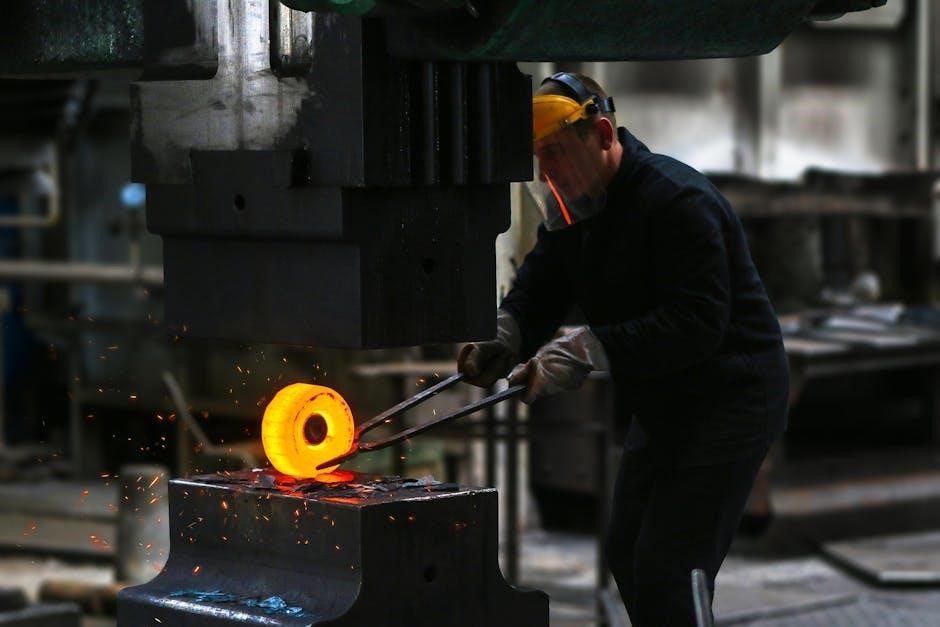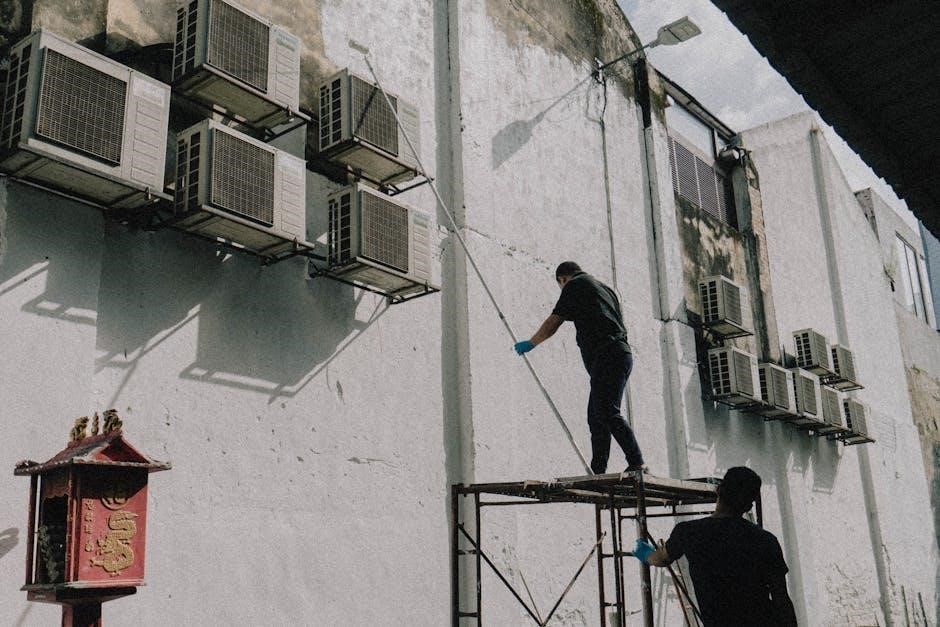Manual dampers are essential components in HVAC systems, regulating airflow to control temperature and comfort․ They are adjusted by hand, unlike motorized dampers, and are crucial for system efficiency․
1․1 Definition and Purpose of Manual Dampers
A manual damper is a metal plate or blade installed within HVAC ductwork to regulate airflow by opening or closing․ Its primary purpose is to control air distribution, balancing temperatures across spaces․ Unlike motorized dampers, manual dampers are adjusted by hand, offering a simple, cost-effective solution for airflow management․ They are essential for maintaining consistent comfort levels and system efficiency, allowing users to direct air where it’s needed most․ Proper use of manual dampers ensures optimal heating, cooling, and ventilation, making them a fundamental component in residential and commercial HVAC systems․
1․2 Difference Between Manual and Motorized Dampers
Manual dampers are adjusted by hand, requiring physical access to modify airflow, while motorized dampers are controlled automatically via thermostats or smart systems․ Motorized dampers offer convenience and precision, adjusting without manual intervention, ideal for zoning systems․ Manual dampers are cost-effective and simple to install, suitable for systems without complex control needs․ They lack automation, requiring users to alter settings manually, which can be time-consuming․ Motorized dampers provide real-time adjustments, enhancing efficiency, but are more expensive to install and maintain․ Both types serve the same purpose of airflow regulation but differ in operation, cost, and functionality, catering to different HVAC system requirements and user preferences;

Types of Manual Dampers
Manual dampers are categorized into rectangular, round, and multi-blade designs, each offering distinct airflow control capabilities tailored to specific HVAC system requirements and ductwork configurations․
2․1 Rectangular Dampers
Rectangular dampers are commonly used in HVAC systems for their versatility and ease of installation in standard ductwork․ They feature a straightforward design with a hinged gate that opens and closes to regulate airflow․ These dampers are typically mounted in rectangular ducts and are ideal for applications where precise airflow control is necessary․ They are often preferred for their durability and ability to withstand various environmental conditions․ Rectangular dampers are widely used in both residential and commercial settings, making them a fundamental component in air distribution systems․ Their simplicity ensures they are both cost-effective and easy to maintain․
2․2 Round Dampers
Round dampers are designed for use in circular or spiral ductwork, offering a smooth airflow control solution․ Their cylindrical shape allows for easy installation in round ducts, making them ideal for systems requiring precise airflow regulation․ These dampers are often used in applications where space is limited or where a compact design is preferred․ They feature a rotating blade that adjusts to control airflow efficiently․ Round dampers are durable and resistant to wear, ensuring long-term performance․ They are commonly used in commercial HVAC systems but are also suitable for residential setups․ Their design ensures minimal airflow restriction when fully open, making them a practical choice for various air distribution needs․
2․3 Multi-Blade Dampers
Multi-blade dampers are specialized HVAC components designed to regulate airflow with precision․ They feature multiple parallel blades that open or close simultaneously, allowing for fine-tuned control over air distribution․ These dampers are typically used in larger or more complex systems where precise airflow balancing is critical․ The multiple blades provide a larger surface area, enabling smoother transitions between open and closed positions․ Multi-blade dampers are often installed in main trunk lines or branch ducts to manage airflow to different zones or rooms․ Their design ensures even air distribution, making them ideal for commercial and industrial applications where consistent temperature control is essential․

Installation and Location of Manual Dampers
Manual dampers are strategically installed in ductwork near HVAC units, main trunk lines, or branch ducts to regulate airflow efficiently․ Their accessible locations simplify adjustments for system balancing․
3․1 Ideal Locations for Manual Dampers in Ductwork
Manual dampers are typically installed near the HVAC unit, main trunk lines, or branch ducts to ensure precise airflow control․ Placing them 2-6 feet off the main trunk makes them easily accessible for adjustments․ This strategic positioning allows for effective regulation of air distribution to different zones or rooms․ Proper installation ensures that dampers can balance airflow efficiently, preventing uneven heating or cooling․ Additionally, installing dampers near vents or registers can help in fine-tuning the air supply to specific areas, enhancing overall system performance and comfort․
3․2 How to Identify Dampers in Your HVAC System

To identify manual dampers in your HVAC system, start by inspecting the ductwork near the main trunk lines and branches․ Look for metal plates with handles or levers, typically located 2-6 feet from the HVAC unit or near vents․ Unlike motorized dampers, manual dampers lack motors or wires, making them easily recognizable․ Check for labels indicating “damper” or “manual control․” To verify their position, have someone cover each vent while you adjust the damper to feel airflow changes․ This method helps determine if dampers are open or closed, ensuring proper system operation and airflow balance․

Operation and Adjustment of Manual Dampers
Manual dampers are adjusted by hand using a handle or lever, allowing airflow regulation․ They can be fully open, closed, or partially open for precise control and balance․
4․1 How to Manually Adjust Dampers for Airflow Control
Manually adjusting dampers involves rotating the handle or lever to open or close the blades, regulating airflow․ Open dampers allow maximum flow, while closing them restricts it․ Partial adjustments fine-tune air distribution, balancing system performance․ Always ensure the handle moves smoothly and blades align properly to avoid leakage․ Seasonal adjustments help optimize comfort, while consistent monitoring maintains efficiency․ Proper technique prevents damage and ensures precise control, making manual dampers a reliable solution for airflow management in HVAC systems․
4․2 Balancing Airflow Using Manual Dampers
Balancing airflow with manual dampers ensures even air distribution across your HVAC system․ By adjusting the dampers, you can regulate the air quantity delivered to different zones or rooms․ Proper balancing prevents uneven heating or cooling, improving overall comfort․ Start by assessing airflow in each area, then gradually open or close dampers to achieve the desired balance․ This process may require trial and error, as slight adjustments can significantly impact airflow․ Regular checks and seasonal adjustments help maintain optimal performance․ Balancing airflow manually is a cost-effective way to ensure your HVAC system operates efficiently and effectively year-round․
4․3 Common Adjustments for Seasonal Comfort
Manual dampers allow for seasonal adjustments to optimize comfort and energy efficiency․ In summer, closing dampers to unused areas redirects cooled air where needed․ In winter, opening dampers to colder zones ensures warm air circulation․ Adjustments often involve balancing airflow to match seasonal demands, such as reducing ventilation to unused rooms or focusing airflow on specific areas․ Regular seasonal tweaks help maintain consistent temperatures and prevent energy waste․ By strategically opening or closing dampers, homeowners can adapt their HVAC system to changing weather conditions, enhancing overall comfort and system performance throughout the year․

Maintenance and Troubleshooting of Manual Dampers
Regular cleaning and inspection of manual dampers ensure proper airflow and system efficiency․ Lubricate moving parts and check for air leaks to maintain optimal performance․
5․1 Cleaning and Inspecting Manual Dampers
Cleaning and inspecting manual dampers are crucial for maintaining proper airflow and system efficiency․ Start by turning off the HVAC system to ensure safety․ Remove any dust, dirt, or debris using a soft brush or vacuum cleaner․ Inspect the damper blades for signs of damage, rust, or corrosion․ Lubricate the hinges and moving parts if necessary to ensure smooth operation․ Check for air leaks around the damper seals and tighten any loose screws․ Regular maintenance prevents blockages and ensures precise airflow control, which is essential for consistent heating and cooling․ Always refer to the manufacturer’s guidelines for specific cleaning recommendations․
5․2 Common Issues with Manual Dampers
Common issues with manual dampers include air leaks due to worn or damaged seals, which reduce system efficiency․ Corrosion can occur in damp environments, causing blades to stick or rust․ Misalignment during installation may prevent proper closure, disrupting airflow․ Dirt and debris accumulation can obstruct damper movement, requiring frequent cleaning․ Over time, hinges and moving parts may wear out, leading to difficulty in adjusting the dampers․ In some cases, dampers may become stuck due to poor maintenance or extreme temperatures․ Regular inspection and maintenance are essential to address these issues promptly and ensure optimal system performance․

Best Practices for Using Manual Dampers
Always adjust dampers gradually to avoid sudden pressure changes․ Regularly inspect for leaks and damage to ensure optimal airflow and system efficiency․ Maintain consistent adjustments to prevent overworking your HVAC system, which can lead to increased energy bills and wear․ Schedule annual checks to clean and lubricate moving parts, ensuring smooth operation․ Never force dampers open or closed, as this can cause mechanical damage․ Keep vents clear of obstructions to allow unrestricted airflow, enhancing overall system performance and comfort․ By following these practices, you can extend the lifespan of your manual dampers and maintain a balanced HVAC system․
6․1 When to Keep Dampers Open or Closed
Manual dampers should be kept open in areas requiring consistent airflow, such as living rooms, to ensure even heating or cooling․ During extreme weather, closing dampers in unused spaces redirects airflow to occupied areas․ In summer, close dampers to upper floors if heat rises, promoting cooler air circulation downstairs․ Conversely, in winter, open dampers to upper floors to prevent overheating․ Always maintain some airflow through dampers to avoid pressure imbalances․ Adjusting dampers seasonally helps optimize comfort and energy efficiency․ Regularly inspect dampers to ensure they are functioning correctly, and avoid leaving them partially closed for extended periods, as this can strain the HVAC system․
6․2 Avoiding Damage to Your HVAC System
Manual dampers play a crucial role in preventing damage to HVAC systems by ensuring proper airflow balance; Closing dampers completely can create pressure imbalances, potentially harming the system․ Partially closing dampers for extended periods can strain the system, so adjustments should be made carefully․ Always ensure at least minimal airflow through dampers to avoid overworking the HVAC unit․ Seasonal adjustments help maintain efficiency and prevent damage․ Regular inspections of dampers ensure they function correctly, avoiding issues like blocked vents or malfunctioning components․ Proper damper management extends system lifespan and prevents costly repairs․




Leave a Reply
You must be logged in to post a comment.